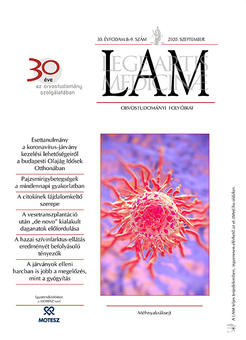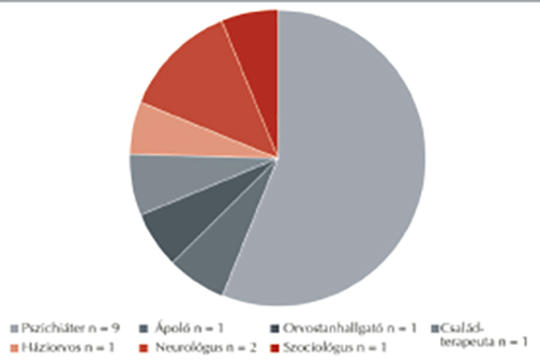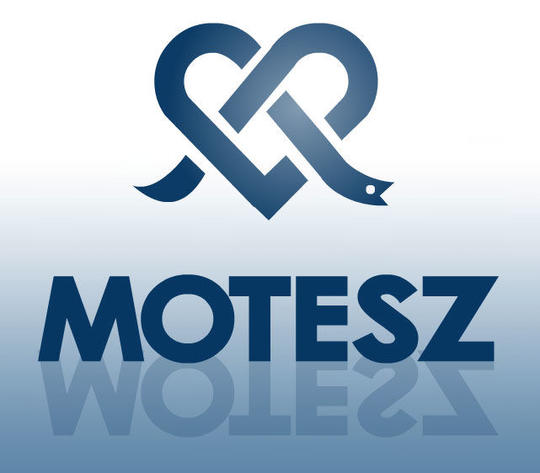The eLitMed.hu medical portal uses computer cookies for convenient operation. Detailed information can be found in the Cookie-policy.
Lege Artis Medicinae - 2020;30(08-09)
Content
[Thyroid disease – essentials for the everyday practice]
[Thyroid disorders are very frequent not only among endocrine diseases but also the general conditions. Every clinician, regardless of their specialty, meet patients with thyroid disorders during their everyday practice. While diagnostic and therapeutic options remained almost unchanged in the past decade, there are several intensively researched topics in the patient’s care, advances of which we ought to familiarize ourselves with. In this present paper we sought out to cover three of these fiercly discussed topics. ]
[The pain-trigger role of cytokines in the nervous system – the direct analgesic effect of anti-cytokine therapy ]
[Nociceptive, neuropathic and central mechanisms are involved in the perception, transmission and processing of chronic pain and shaping of cerebral pain image. Alarmins – molecules alarming defence and signing the presence of pathogens and tissue damage - trigger a series of pathogenic events resulting in inflammatory pain stimuli. Proinflammatory cytokines play a determining role in the pain perception at the level of the nervous system. Continuous inflammatory stimuli while sensitizing the periferic and central neurons activate the pain-related cerebral areas and develop the complex pain image, the pain matrix. Cerebral functional connections are operating in networks and can be visualized by functional MRI. Cytokines activate the neurons directly or indirectly by other neuromediators. Cytokine receptors are expressed on nociceptors and even on higher-level neurons and on various non-neural cells, such as microglia and astrocytes. The most ubiquitous cytokines are the Tumour Necrosis Factor and Interleukin 6 in the nervous system. The signaling pathways are the Nuclear Factor κB and the Janus-kinase enzyme system. The proinflammatory cytokines and the Janus-kinase are therefore primary therapeutic targets. Anti-cytokine biologicals and small molecular kinase inhibitors decrease the pain and improve functional activity in rheumatoid arthritis. Decrease of pain was more pronounced than expected only from the decrease of the clinical biomarkers of inflammation. The early and rapid painkiller effect of targeted biological and chemical-biological response modifiers is attributed to their direct analgesic effect on the brain.]
[Case report about the choice of care at Olajág Elderly Home in Budapest during the COVID-19 epidemic in spring 2020]
[During the COVID-19 pandemic caused by the SARS-CoV-2 virus, elderly people in long-term nursing homes were especially risks exposed. In this study, the authors analyse the causes of local outbreak at the Olajág Elderly Home Vezér street facility in Budapest and the means and ways to curb the spreading of infection. They summarise the measures, which proved to be effective in isolation and treating the patients. The number of infected residents as well as the course of the disease are demonstrated by statistical data. The authors consider as pre-eminently important to identify asymptomatic but infected residents, further the rapid introduction of screening tests, strict compliance with protocols, patient path regulation and the use of enhanced, supportive communication.]
[Frequency and risk factors of “de novo” tumors after kidney transplantation ]
[After kidney transplantation, the administration of immunosuppressive therapy not only renders the patient susceptible to infections, but it may also damage the function of tumor cell recognition and elimination. Our study was performed at the Department of Surgery, University of Szeged. After establishing the inclusion criteria, 570 patients were involved in the study. We examined the age, sex, immunosuppressive therapy of the patients, and searched for the relationship between the different immunosuppressive agents and the type of the tumor. In 81 cases, de novo cancer was diagnosed. Among patients treated with cyclosporin and tacrolimus there was no significant difference in the mean age (p = 0.734) and body mass index (p = 0.543). There was no significant difference in graft function between the two groups of patients (Tac vs Cyc; 44 vs 20). Related to the time passed since the transplantation to diagnosing the tumors the earliest were prostate and cervix cancers however without significant difference. Skin cancers are the most frequent followed by post-transplant lymphoproliferative diseases. The increasing risk of developing tumors is mainly due to immunosuppressive therapy. ]
[Assessment of multidisciplinary teams in psychiatric care – Lessons of three focus groups ]
[Our research group, has studied psychiatric and psychotherapeutic teams since 2015. The aim of the present research was to identify the Hungarian characteristics of team composition and operation. Qualitative focus group survey has been conducted on the operation of multidisciplinary teams at the annual conferences of the Hungarian Psychiatric Society in 2017, 2018 and 2019. These three groups focused on the issues of leadership, communication within the team, and competencies. The groups of an average of 17 people formed spontaneously by participation of professionals with different qualifications. The main results of the focus groups were as follows: 1. The various types of leadership within the team require the distribution and allocation of responsibilities and roles and stop the destructions. 2. Within the teams there are prevailing the informal channels of communication. 3. It is important to clarify competencies and responsibilities. 'Actually, psychiatric specialists' list of competencies there is not available in Hungary. It seems necessary to define more precisely and reconsider the professional competences of the specialized training in psychiatry and integrating these in the education, further promote the development of „list of competences in psychiatric specialization” by the legislators. The second phase of the research continues as a quantitative study based on the foregoing results gained by questionnaires. ]
[How can the specialists be contacted? Ways of communication in the specialist-patient consultation]
[Consulting the specialist means face-to-face meetings traditionally. Nowadays patients do not need to go to the outpatient clinic to see the doctor since many new communication options have already been available. The aim of our study was to explore how typically doctors and patients use other options (as phone call or e-mail) beside face-to-face appointments in the outpatient clinic. We conducted a focus group interview with specialists and health workers and an in-depth interview with the chief nurse of an outpatient clinic in Budapest. The specialist-patient consultation is mostly face-to-face in the specialist’s office in the presence of the nurse, whose role is complex and pivotal. Furthermore, the landline phone is an essential device, as the patients can reach the specialist or nurse in their office hours. The application of e-mail or mobile phone is incidental. The website of the outpatient clinic provides practical information to patients. Traditional postal letters, leaflets, and publications are also typical for providing information. The doctors’ opinion was rather heterogeneous about the patients’ Internet usage and about the online contact with patients. Beside increasing the capacities the deliberate and organized introduction and application of technical devices, may reduce the overburdening of health professionals.]
[A forgotten physician in the history of Hungarian Psychiatry. Dr. Ferenc Klein’s biography]
[The Psychiatry Department of St. Raphael’s Hospital in Zala County celebrated its 110th anniversary last year. This important anniversary raised the idea of studying deeper than usual the life of our professional ancestors. We tried to discover the personality, character, and oeuvre of our first appointed chief physician Ferenc Klein while using historical recollections and press articles published by our county, city and hospital. An image of a prominent physician, psychiatrist, patriot and individual was emerging before our very eyes by processing the available sources. As a pulmonologist, a field surgeon, or a psychiatrist he was able to meet the expectations of his age. He was highly appreciated by his patients and the people of Zalaegerszeg. Despite his significant oeuvre and martyrdom, he sank in oblivion and his name was not preserved either in the history of psychiatry or in the general memory. In the present study, we want to commemorate him by collecting and publishing his biography. ]
[Analysis of factors influencing the efficacy of Hungarian acute cardiac care]
[Despite the modern invasive acute cardiac care available for all, as opposed to short-term mortality, the long-term mortality of Hungarian myocardial infarction patients exceeds significantly those of European patients getting similar treatment. In order to change this situation, it is necessary to assess and analyse exactly the factors behind. While analysing retrospectively the data of Hungarian acute myocardial infarction patients, we identified the influencing factors of short- and long-term mortality. This study processed data from 2003 to the present days from a number of registries (Heart- and Vascular Center of Semmelweis University VMAJOR I and VMAJOR II registry, Stent for Life I and II Programs of the European Society of Cardiology, National Public Health Service’s registry about Cardiac Care in Central Hungary, Budapest Modell database). According to our detailed examination, the proportion of primary percutaneous coronary intervention in ST-segment elevation myocardial infarction is at Western-European level, however the invasive treatment of acute coronary attack patients with Non-ST segment myocardial infarction is below the required. The so-called hesitation span of Hungarian patients with ST-segment myocardial infarction is substantially longer than that of neighbouring countries thus the average cardiovascular risk of relevant Hungarian patients is significantly higher than those of the GRACE Register’s population. Based on our results a complex strategy can be developed which may have impact also on strategic healthcare decisions in order to reduce the long-term mortality of patients surviving myocardial infarction.]
1.
Clinical Neuroscience
Is there any difference in mortality rates of atrial fibrillation detected before or after ischemic stroke?2.
Clinical Neuroscience
Neuropathic pain and mood disorders in earthquake survivors with peripheral nerve injuries3.
Journal of Nursing Theory and Practice
[Correlations of Sarcopenia, Frailty, Falls and Social Isolation – A Literature Review in the Light of Swedish Statistics]4.
Clinical Neuroscience
[Comparison of pain intensity measurements among patients with low-back pain]5.
Journal of Nursing Theory and Practice
[Fear of Falling among Geriatric Patients: a Narrative Review]1.
Clinical Neuroscience
Recurrent simultaneous central nervous system demyelination with possible peripheral demyelination / nodopathy in a seronegative patient2.
3.
Clinical Neuroscience
Predictors of pneumonia in stroke patients with dysphagia: A Turkish study4.
5.
Clinical Neuroscience
Effect of inflammatory response before mechanical thrombectomy on prognosis in stroke patients









